The global wooden decking market is estimated to be valued at USD 8.35 Bn in 2025 and is expected to reach USD 10.48 Bn by 2032, growing at a compound annual growth rate (CAGR) of 3.3% from 2025 to 2032.
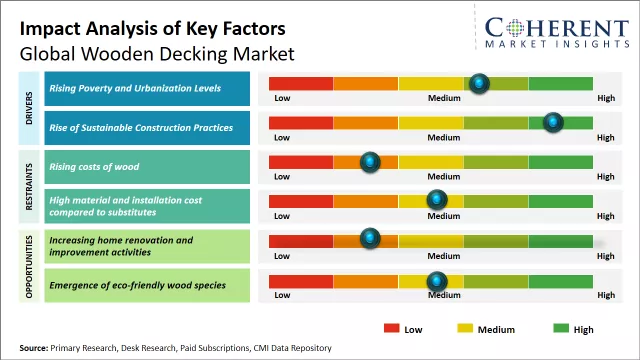
Discover market dynamics shaping the industry: Request sample copy
Wooden decking market is observing significant growth owing to the increasing construction of new residential and commercial properties worldwide. Wooden decking offers aesthetically pleasing looks along with durability making it a preferred choice of material for outdoors construction. Moreover, growing interest of people in spending leisure time with friends and family in outdoor spaces is further propelling the demand for wooden decking in developed regions. However, high cost of advanced wooden decking materials and increasing popularity of less expensive substitutes like composites may hinder the market growth during the forecast period.
Rising Poverty and Urbanization Levels
As poverty levels continue to increase in developing nations, more people are moving to urban centers looking for employment opportunities and a better standard of living. However, finding proper housing in crowded cities is challenging. Many settle for cheaper apartments or rented rooms lacking private outdoor spaces. Wooden decking provides a cost-effective solution to extend living areas outside while maintaining privacy. It allows light and air to enter cramped indoor spaces. Decking projects are also becoming popular in apartment complexes and group housing as a way for residents to socialize and spend time outdoors. The growing affordable housing crisis and mass urbanization unfolding in Asia pacific and Africa is fueling the demand for basic wooden structures that can enhance livability without consuming much indoor space. Decking helps optimize the limited area available in densely populated urban locations.
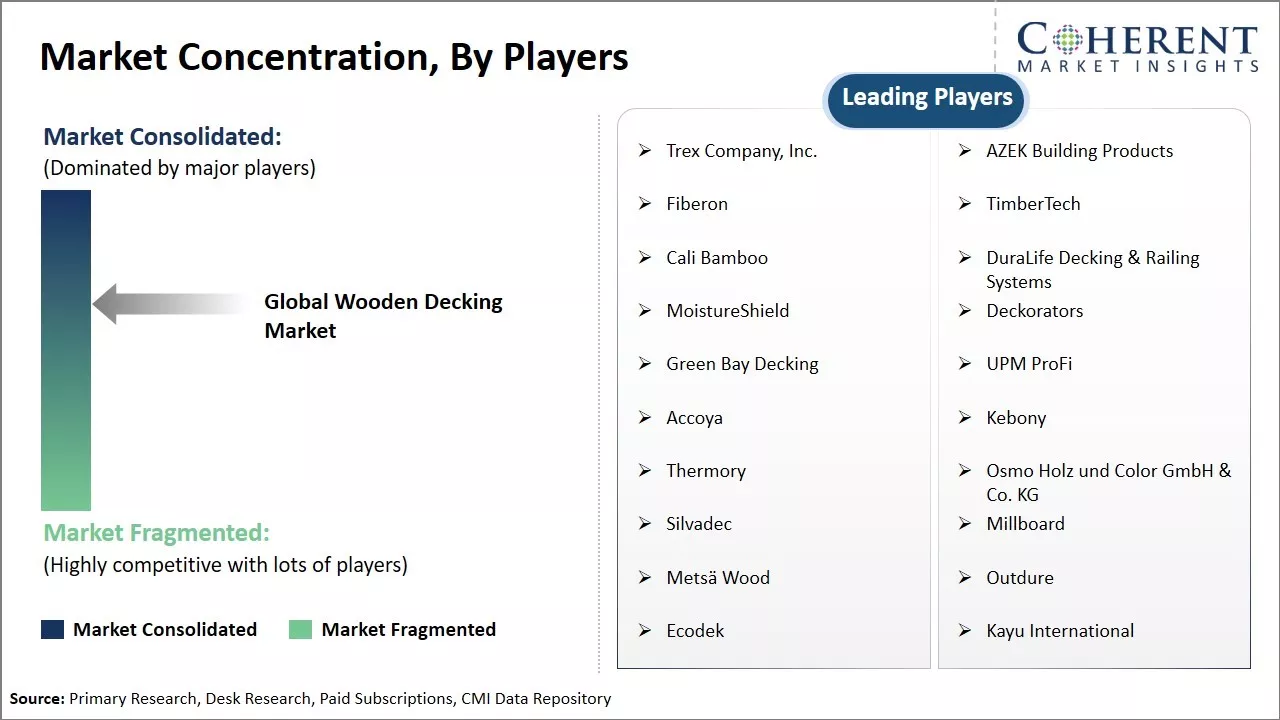
Get actionable strategies to beat competition: Request sample copy
Rise of Sustainable Construction PracticesThere is a rising global shift toward greener and more environment-friendly building materials. Wooden decking made from recycled or reclaimed timber has less embodied carbon footprint compared to materials like concrete or steel. It can also be dismantled and reused at the end of the structure's lifespan. This attributes to wood's sustainable credentials and makes decking an appealing option for both residential and commercial projects targeting LEED or BREEAM certifications. Several developed economies in Europe and North America have formulated new construction codes promoting the use of renewable building products. Additionally, many homeowners now prefer decking for its natural aesthetics and ability to blend harmoniously into outdoor landscapes. The growing market preference for sustainable buildings and materials is contributing to wooden decking gaining wider acceptance across end-use segments.
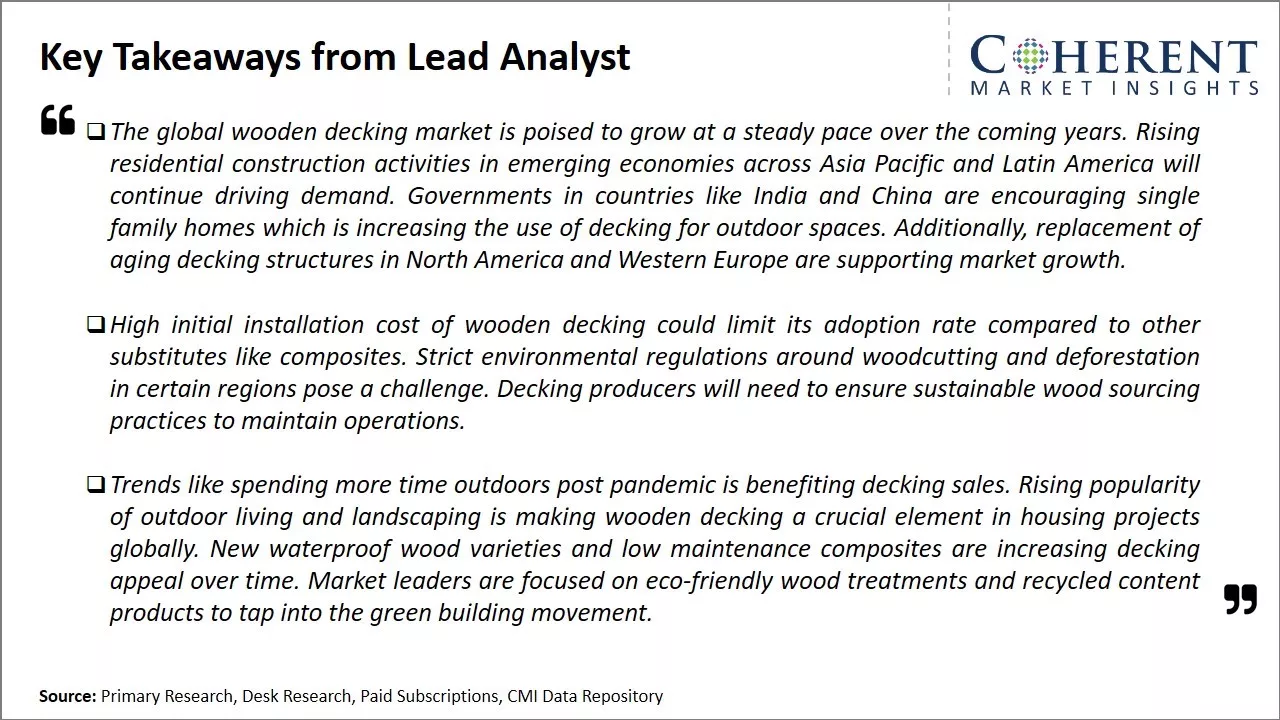
To learn more about this report, Request sample copy
Challenges: Rising costs of woodRising costs of wood are negatively impacting manufacturer margins. Additionally, strict environmental regulations around deforestation pose supply risks. Wood is susceptible to damage from moisture, insects, and weathering if not properly maintained. Composite decking materials are gaining preference over wood due to lower maintenance needs. Developing alternatives to tropical hardwoods also remains a challenge as these varieties provide premium aesthetics and performance.
Opportunities: Increasing home renovation and improvement activities
Home renovation and improvement activities are driving the replacement decking demand. More durable and real-wood appearing composite materials are expanding the addressable market. Growth in outdoor living and grilling culture is supporting deck extensions and upgrades. Increased durability and lifespan of bamboo- and eucalyptus-based woods presents options at competitive price points.
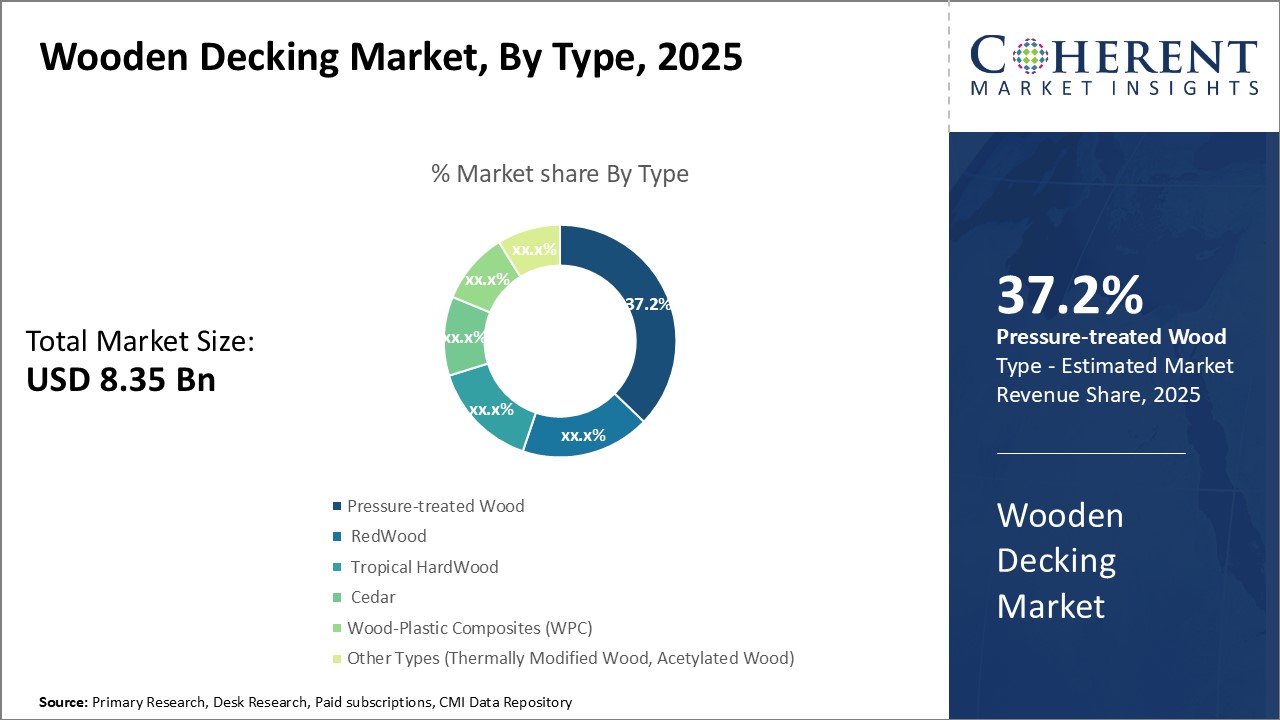
Discover high revenue pocket segments and roadmap to it: Request sample copy
Insights by Type: Durability Drives the Demand for Pressure-treated WoodIn terms of type, pressure-treated wood is expected to contribute 37.2% share of the market in 2025 owing to its exceptional durability. Made from pine, fir or other wood species treated with creosote or CCA preservatives under heavy pressure, pressure-treated wood can withstand the elements for decades without rotting or decaying. This makes it the material of choice for applications that require longevity even when continuously exposed to moisture, such as decking boards, patio furniture, playsets, and boardwalks. The durability of pressure-treated wood stems from its production process. Subjecting raw lumber to heavy pressure forces preservatives deep within the cellular structure of the wood, penetrating up to 1 inch deep. This protects both the surface and inner layers from moisture and insect damage. Compared to untreated woods which may only last 3-5 years before signs of deterioration appear, pressure-treated wood can be expected to maintain its structural integrity for 15-50 years depending on the climate conditions and level of exposure. Another key advantage of pressure-treated wood is its similar appearance to traditional lumber once installed. While some newer wood-plastic composite materials may have a more modern aesthetic, many consumers still prefer the natural wood grain texture that pressure-treated lumber provides. This allows it to blend seamlessly into outdoor living spaces without appearing out of place. Pressure-treated wood is also cost effective relative to other long-lasting materials like redwood or tropical hardwoods. With a long service life and affordable initial price point, its high durability translates into favorable whole-life costs.
Insights by Application: Design Flexibility Boosts the Flooring Demand
In terms of application, floor is expected to contribute 37.8% of the market share in 2025 due to its ability to transform interior and exterior spaces. Decking floorboards offer versatile design possibilities limited only by the builder's imagination. Whether creating a simple porch, expansive entertaing areas, or seamless indoor-outdoor flow, flooring plays a central role in defining the style, function, and ambiance of a space. Beyond basic deck configurations, flooring allows expression through details like custom layout patterns, edge treatments, and incorporated design features. Angled boards, contrasting inlays, and built-in lighting are some examples of how flooring expands creative options. Multi-level deck designs with varying elevations further enhance functionality. Flooring also enables composite decking materials like WPC to realistically replicate the look of other natural wood types indoors. On the residential front, deck and patio flooring satisfies the growing consumer demand for enhanced outdoor living. It expands usable living area that blurs the dividing line between inside and out. This aligns with modern lifestyles that emphasize alfresco entertaining and indoor-outdoor flow. The fundamental role of flooring in tying all elements of an outdoor project together further stimulates its widespread application across residential construction. In multi-family developments, community spaces also incorporate elaborate decking designs to boost resident amenities and property value.
Insights by End-User: Importance of Wooden Decking in Residential Outdoor Spaces
In terms of End-User, pressure-treated wood is expected to contribute 36.2% share of the market in 2025. Wooden decking is a popular choice for residential outdoor living spaces due to its versatility, durability, and aesthetic appeal. Wooden decking is commonly used to create backyard decks, providing an elevated and functional outdoor living area. These decks can be used for entertaining, relaxing, dining, or as an extension of the indoor living space. Wooden decking is an excellent material for constructing front porches, adding curb appeal and a welcoming entrance to a home. Front porches can be designed with various styles and sizes to complement the architectural features of the residence. Wooden decking can be used to create beautiful and functional walkways and pathways throughout a residential property. These can connect different areas of the yard, lead to a garden, or provide a designated route for foot traffic.
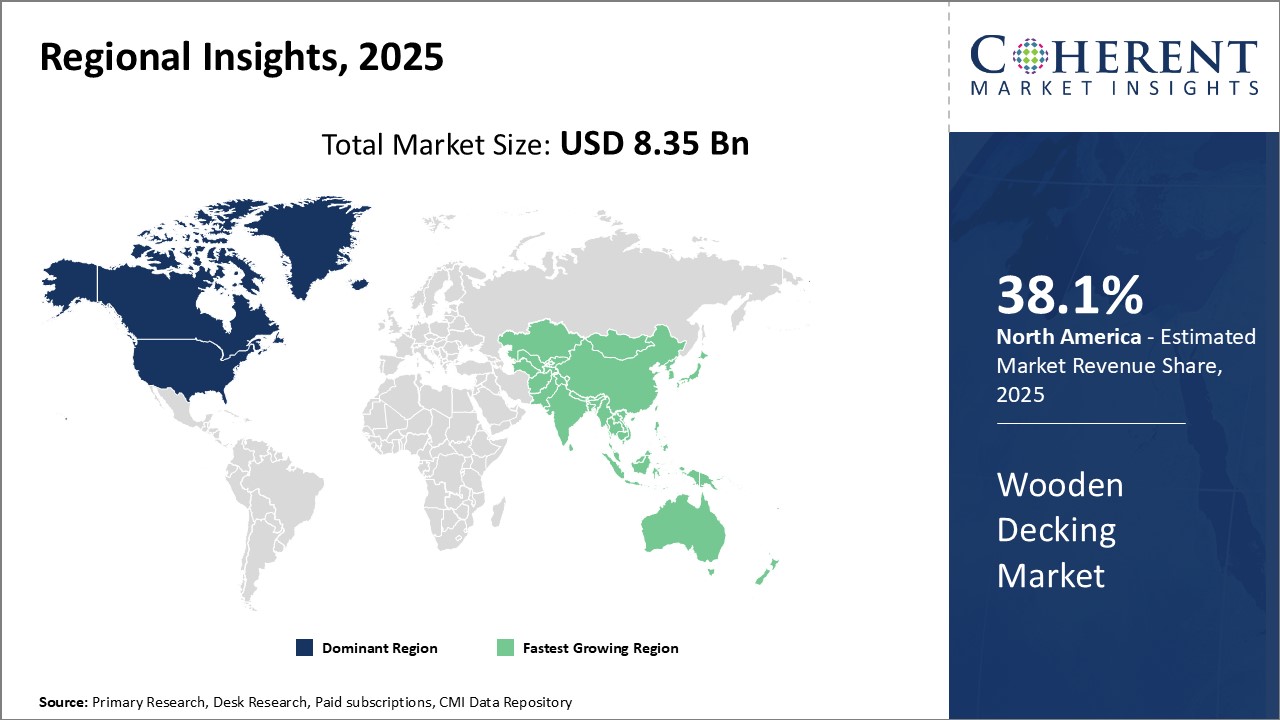
Need a Different Region or Segment? Customize now
North America has been the dominant region in the global wooden decking market for many years. The region is expected to hold 38.1% of the market share in 2025. The U.S., in particular, has shown substantial demand mainly due to increased construction and remodelling activities for residential properties across the country. Majority of the wood decks are built as an extension to the homes to increase outdoor living area. Redwood and pressure treated pine lumber are mostly used raw materials for decking in this region. The presence of leading decking manufacturers and suppliers over decades has ensured the easy availability of a wide range of wood decking products customized as per local preferences and weather conditions. Composite decking material is also gaining popularity as a long lasting substitute for traditional wood. Stringent building codes and permit requirements in the U.S. have further enhanced the market size. Moreover, the outdoor lifestyle of Americans and rising home improvement expenditure continue to drive the demand.
The Asia Pacific region has emerged as the fastest growing market for wooden decking globally. Rising disposable income, growing middle class population, and increasing rate of urbanization are the key macroeconomic factors fueling the demand. Countries like China, Japan, and Australia are experiencing a surge in the construction of private resorts, bungalows, and villas which require extensive use of decking. Tropical rainforest woods indigenous to Southeast Asian countries are now major raw materials for export. Malaysia, in particular, has built a strong foothold in global wooden decking trade over the years through sustainable extraction and crafting of renowned wood types such as merbau and kemuning into quality decking products. Strategic geographical location and well established sea routes provide competitive logistic advantage to Asian decking manufacturers for global market reach and dominance in import reliant regions. The growing recognition and popularity of Asian hardwoods will likely cement Asia Pacific's position as the prime driver of future market expansion.
Wooden Decking Market Report Coverage
| Report Coverage | Details | ||
|---|---|---|---|
| Base Year: | 2024 | Market Size in 2025: | USD 8.35 Bn |
| Historical Data for: | 2020 To 2024 | Forecast Period: | 2025 To 2032 |
| Forecast Period 2025 to 2032 CAGR: | 3.3% | 2032 Value Projection: | USD 10.48 Bn |
| Geographies covered: |
|
||
| Segments covered: |
|
||
| Companies covered: |
Trex Company, Inc. , AZEK Building Products , Fiberon , TimberTech , Cali Bamboo , DuraLife Decking & Railing Systems , MoistureShield , Deckorators , Green Bay Decking , UPM ProFi , Accoya , Kebony , Thermory , Osmo Holz und Color GmbH & Co. KG , Silvadec , Millboard , Metsä Wood , Outdure , Ecodek , and Kayu International |
||
| Growth Drivers: |
|
||
| Restraints & Challenges: |
|
||
Uncover macros and micros vetted on 75+ parameters: Get instant access to report
*Definition: The global wooden decking market refers to the industry for manufacturing and selling wooden materials that are used for constructing exterior decks and walkways. Key products in this market include pressure-treated wood, redwood, cedar, and tropical hardwood decking boards as well as wood-plastic composite and capped composite boards. The decking materials are chosen for their desirable properties like durability, aesthetics, and ability to withstand weather.
Share
Share
About Author
Yash Doshi is a Senior Management Consultant. He has 12+ years of experience in conducting research and handling consulting projects across verticals in APAC, EMEA, and the Americas.
He brings strong acumen in helping chemical companies navigate complex challenges and identify growth opportunities. He has deep expertise across the chemicals value chain, including commodity, specialty and fine chemicals, plastics and polymers, and petrochemicals. Yash is a sought-after speaker at industry conferences and contributes to various publications on topics related commodity, specialty and fine chemicals, plastics and polymers, and petrochemicals.
Missing comfort of reading report in your local language? Find your preferred language :
Transform your Strategy with Exclusive Trending Reports :
Frequently Asked Questions
Joining thousands of companies around the world committed to making the Excellent Business Solutions.
View All Our Clients
US Reciprocal Tax Impact Analysis On Wooden Decking Market
Stay updated on tariff changes with expert insights and timely information